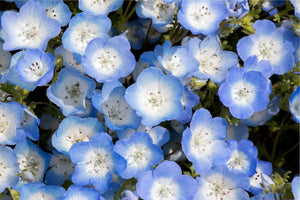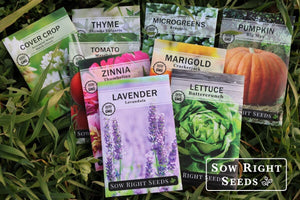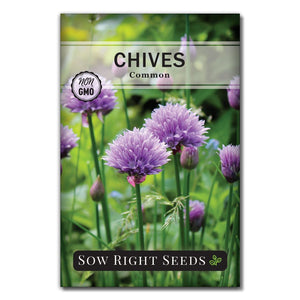4 Vital Tips to Successfully Grow Lemongrass From Seed
Herb growing tipsDo you love Thai food? Do you want an ornamental grass that is also edible? If so, it's time to start growing lemongrass (Cymbopogon flexuosus). Known for its lemony scent and complex lemon flavor, lemongrass is an essential ingredient in all kinds of soups and curries. Learn how to grow it at home, so you always have it on hand.

How to Grow Lemongrass From Seed
It’s easy to grow lemongrass from seed. Like all seed germination--temperature, light, and moisture are vital to successfully germinating seeds.
To better control these critical factors, we recommend germinating lemongrass seeds indoors.

4 Tips For Fail-Proof Lemongrass Seed Germination
1 - Gently press seeds into the soil surface and barely cover them with soil. The planting depth listed on the seed packet is 1/16” because lemongrass seeds need light for germination. It only takes 7 to 14 days for the seeds to germinate.
2 - Keep the soil at a nice tropical temperature of 68º to 86°F. This is easier to do indoors using supplemental heat, such as a seedling heat mat.
3 - Keep the lemongrass seeds moist by using a dome or other cover. If the seeds dry out, they won’t complete their germination process. However, you don’t want the soil to be waterlogged. So a cover helps to keep the moisture in without keeping the soil too wet.
4 - When they are about 3” high, the lemongrass plants will be ready to transplant. Transplant to a warm and sunny spot after all danger of frost has passed. Space plants 12” or more apart to give this tropical grass room to grow and spread.
Additional Points to Know About Growing Lemongrass
Keep small lemongrass plants weed-free when they are young. Once they are growing in the hot summer weather, they will quickly overtake any weeds and other grasses.
Lemongrass is a tender perennial which means it doesn’t tolerate frost. Its ideal life is enjoying bright sunshine and warm temperatures. Which means at least 6 hours of sunlight and a daytime temperature of 75º with 60º nights.
Lemongrass can be a perennial in growing zones 10 to 11. In zones 8 to 9, it can die back in the winter and grow back in the spring. For colder zones, you will need to bring lemongrass plants indoors to overwinter or plant from seed in the spring. If overwintering, bring lemongrass plants indoors before the nighttime temperatures drop below 50º.
If grown in a container, this tropical plant can be contained from spreading and then easily moved indoors during the winter. But the roots can quickly fill up a pot so make sure you have a container at least 12” in diameter. Lemongrass doesn’t mind being transplanted so it’s easy to divide and move to other spots or share with a gardening friend.
Lemongrass grows in clumps and produces lots of stalks. You won’t need to grow a lot of plants to get your fill of lemongrass tea.

Harvesting Lemongrass
Lemongrass is ready to harvest when the base of the stalk is 1/2” wide. There will be layers of leaves and a white center core. This core is the more tender part of the plant. With a sharp knife or scissors, cut at the base just below the white core. Or bend the stalk back and twist it to pull it out.
Lemongrass has sharp leaves, so you may want to wear gloves.
Ways to Use Lemongrass
An essential ingredient in Thai, Vietnamese, Cambodian, and Indonesian cooking, lemongrass gives a lemony flavor without the bitterness and has a more complex flavor. The flavor is often described as having hints of ginger and florals.
Lemongrass is very woody and not easy to chew. To release the full flavor and scent, lemongrass needs to be chopped or smashed. It works well in dishes that simmer for a long time. Even though the white part is more tender, it does need to be chopped fine or smashed into a paste to make it more palatable.
It is considered an aromatic because it is usually added to soups and sauces, and then the pieces are removed before serving.
Lemongrass can be made into a sugar syrup and used as a flavoring for tea and ice cream.
Pair it with Thai basil, coconut milk, or ginger.
Lemongrass leaves and stalks can be kept in the fridge for a week or two.
Freezing Lemongrass
Lemongrass is easy to freeze and does not need blanching before freezing. You can freeze stalks or cut them up into smaller pieces first.
Drying Lemongrass
To dry lemongrass, cut the leaves and hang them in a warm location or use a food dehydrator. Dried lemongrass can be used in soups and sauces where it can rehydrate.

Lemongrass FAQs
Is Lemongrass Easy to Grow?
Lemongrass grows quickly and is easy to grow and propagate. It can be grown from seed and can grow two feet wide and 6 feet tall in one year.
When to Plant Lemongrass
Lemongrass can be planted outdoors when the evening temperatures stay above 60º F. Lemongrass is a tender perennial and is not tolerant of frost.
Where Should I Plant Lemongrass?
There are two things to remember about lemongrass when choosing a location. First, the leaves of lemongrass are sharp, and second, they can spread out 2 feet and grow up to 6 feet high. These considerations can make it a good plant to put on property borders along fencelines or other places where it can grow and not become a nuisance.
How to Make Lemongrass Tea
Lemongrass tea is a delicious way to enjoy this tropical grass. Besides the taste, many people enjoy the aromatic scent and use the tea not only to drink but as part of aromatherapy. Cut lemongrass leaves into 2-inch pieces and boil for 5 minutes. If desired, you can sweeten your tea with honey. It is delicious warm or cold.
What Are the Medicinal Uses of Lemongrass?
- For inflammation and easing digestion
- Oil is rubbed into sore muscles
- Used as a tea to treat sore throats
- Lemongrass essential oil is used for perfumes and insect repellents.
Is Lemongrass Toxic to Pets?
Lemongrass can be mildly toxic to dogs and cats, according to the ASPCA. When cats and dogs nibble on the leaves, it can cause stomach upset. But often, they have to eat more than just a nibble when they walk by. The bigger concern is if they eat a lot of it because dogs and cats can’t digest the grass, it can cause blockages.
The unique flavor of lemongrass makes it an essential component of many recipes. There's just no substitute. And since it's so easy to grow, it's time to add lemongrass to your garden.







Leave a comment